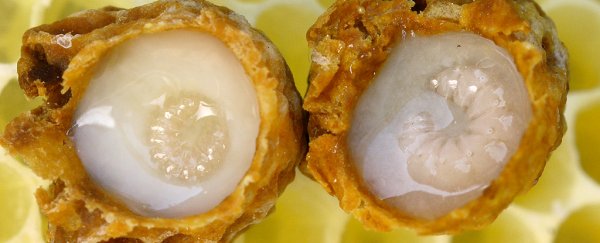Honey bees really are tiny hardworking superheroes of the insect world - not only do they keep our agriculture going by pollinating many of our crops, but they also produce a myriad of beneficial substances, like honey and beeswax.
For thousands of years honey has been prized for its topical antiseptic properties. But now researchers have discovered that its lesser-known cousin, royal jelly, has special molecules that speed up wound healing.
Royal jelly is the superfood worker bees secrete and feed all their larvae, especially the queen bees. While queens are developing, they basically float in a pool of this stuff, and humans have figured out how to stimulate queen larva production to then harvest the royal jelly.
The milky white, sticky substance is one of those bee-derived products you can find in many health food shops, although evidence for royal jelly as a beneficial food supplement is extremely limited.
But there is some evidence that it is both antiseptic and promotes wound healing, and scientists have been wondering why that's the case.
Now a team led by researchers from the Slovak Academy of Sciences have finally discovered the molecule in royal jelly that helps certain skin cells to reorganise themselves and close over a wound.
When skin is damaged, two main types of cells need to spring into action. These are fibroblasts and keratinocytes, which kick in to produce molecules that speed up the proliferation of new cells the skin can use to repair the damage.
The royal jelly molecule that helps skin cells with this job turns out to be a peptide called defensin-1. It belongs to a large class of small antimicrobial proteins found in plants and animals, including humans.
This particular defensin-1 peptide speeds up the production of an enzyme called MMP-9, which plays an important role in rebuilding the cell matrix in the skin.
In previous work the team investigated a different protein they thought was responsible for accelerated wound healing, but it turned out to not speed up the production of the helpful enzyme in human keratinocytes.
"One potential candidate that potentially participates in wound healing is MRJP1, which is the dominant honeybee protein present at high levels in both royal jelly and honey," the researchers write in the study.
Bee defensin-1, on the other hand, significantly increased the production of MMP-9 when the researchers tested it on keratinocytes in a petri dish.
"Similar to MRJP1, defensin-1 is a common but quantitatively variable factor present in both royal jelly and honey," the team writes.
After isolating this peptide and testing it in the dish, the researchers then went ahead to see how it would perform on actual wounds. They anaesthetised 20 rats and gave each of them four wounds on the back.
One wound was treated with a royal jelly ointment, one with an isolated defensin-1 ointment, one was treated with just the neutral vehicle gel that was used for these ointments, and the last one was left untreated.
After 15 days, there was a significant difference in the healing speed of the treated wounds versus the controls. Both the royal jelly and the defensin-1 ointments had helped the wounds close over, while the controls were still partially open.
"Taken together, histological analyses showed that royal jelly as well as defensin-1 promoted a complete re-epithelialization of the wound surface and scar formation in the dermis," the researchers concluded.
But the amount of defensin-1 in royal jelly and honey is highly variable, so it doesn't mean we should all rush out to get jars of the stuff to slather on all our cuts and scrapes (especially because, like any bee product, it can also cause an allergic reaction).
Still, this is a really cool finding. With so many active compounds present in all those products that bees manufacture, every time we can isolate one, we get closer to turning it into a great treatment for humans.
The study was published in Scientific Reports.
